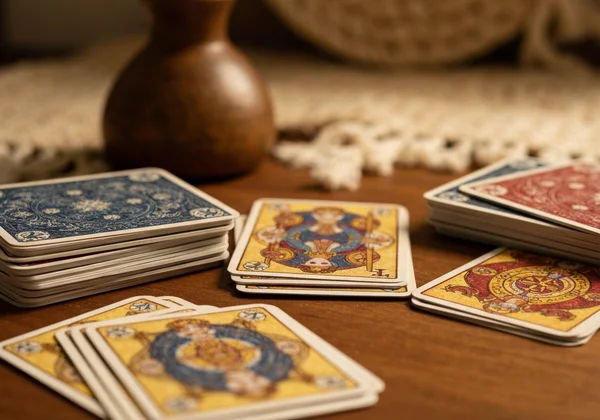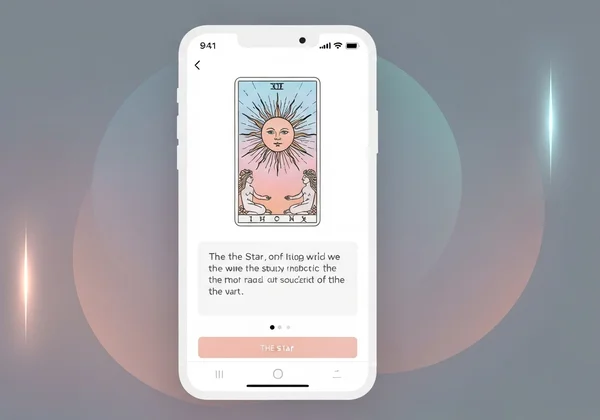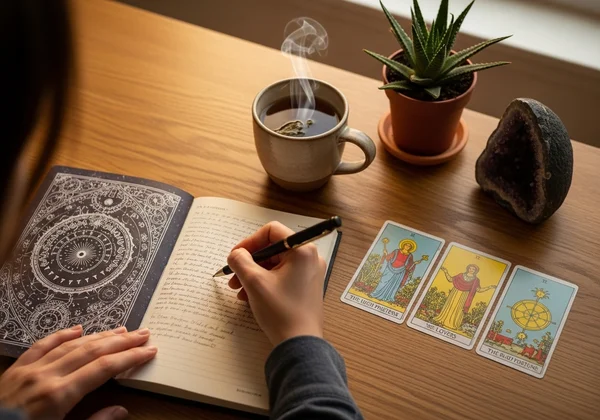Random Tarot Card for Beginners: Your Guide to Daily Readings
Welcome to the mystical world of Tarot! If you've ever felt a pull towards these enigmatic cards, you're in the right place. Many people are curious about tarot for beginners, asking themselves, how to read tarot? This guide is your first step into a practice that's less about fortune-telling and more about self-reflection. Tarot is a powerful tool for introspection, offering a mirror to your subconscious and providing daily insight. It helps you understand your present, reflect on your past, and navigate your future with greater awareness. Are you ready to unlock the powerful wisdom within? You can start your journey today.
Getting Started with Tarot: What You Need to Know
Before you draw your first card, it's helpful to understand the fundamentals. Building a solid foundation will make your readings more meaningful and your connection to the cards stronger. This involves learning the deck's structure, choosing a set that resonates with you, and preparing your space and mind for a reading. This initial setup isn't just a step; it's a crucial ritual that transforms a simple card pull into a mindful journey of self-discovery.
Understanding the Tarot Deck: Major vs. Minor Arcana Explained
A standard tarot deck consists of 78 cards, each with its own unique imagery and symbolism. The deck is divided into two main parts. The Major Arcana includes 22 cards that represent significant life events, spiritual lessons, and major archetypal themes on your journey, from The Fool (beginnings) to The World (completion). The other 56 cards form the Minor Arcana, which reflects the trials and tribulations of daily life. The Minor Arcana is further divided into four suits—Wands, Cups, Swords, and Pentacles—each corresponding to different aspects of human experience like passion, emotions, intellect, and material wealth.

Choosing Your First Tarot Deck: Finding Your Personal Connection
With thousands of decks available, selecting your first tarot deck can feel overwhelming. The most important factor is your personal connection to the artwork and symbolism. Some beginners prefer the classic Rider-Waite-Smith deck for its clear imagery and extensive resources. Others may be drawn to modern, minimalist, or artistically unique decks. Trust your intuition. Browse different styles online or in a local shop. Hold the deck if you can. The right one will feel exciting and speak to you on an intuitive level, making your learning process more enjoyable and personal.
Preparing for a Reading: Cleansing Your Deck & Setting Intentions
Creating a sacred space is key to a focused reading. Don't worry, this doesn't require an elaborate setup—a quiet corner where you won't be disturbed is perfect. Before a reading, many practitioners "cleanse" their deck to clear it of stagnant energy. You can do this by shuffling the cards, knocking on the deck, or fanning them through incense smoke. Equally important is setting an intention. Take a deep breath and focus on the question or area of your life for which you seek clarity. This helps direct the energy of the reading and ensures you receive relevant guidance. This simple preparation enhances your card interpretation.
How to Read Random Tarot Cards Online: Your Step-by-Step Guide
Now that you have your foundation, it’s time for the most exciting part: your first reading. Remember, learning how to read tarot cards is a journey, not a destination. Start simple, trust your instincts, and be patient with yourself. The goal isn't to predict the future with 100% accuracy but to gain a new perspective on your current situation. As a beginner, using an online tool can be incredibly helpful for practicing without pressure. You can try a free reading anytime to familiarize yourself with different cards and their meanings.
Simple Tarot Spreads: One-Card Pull & Daily Tarot Card Readings
You don't need complex layouts to get a meaningful message. The simplest tarot spread is the one-card pull. This is perfect for daily guidance or a quick answer to a specific question. Simply ask your question, shuffle, and draw one card. This card is the universe's direct message to you for the day. Another excellent beginner spread is the three-card spread, typically representing Past, Present, and Future. This layout provides a narrative, showing you where you've come from, where you are now, and the potential direction you're heading. Our platform makes it easy to explore spreads and receive instant interpretations.

Tarot Card Interpretation: Keywords, Symbolism, and Meanings for Beginners
This is where art meets intuition. Each card has traditional tarot card meanings, which you can learn from guidebooks or online resources. Start by looking at the card's imagery. What colors, symbols, and characters do you see? What story do they tell? What emotions do they evoke in you? Your personal response is a vital part of the interpretation. Combine this intuitive feeling with the card's established keywords to form a complete message. Don't worry about getting it "right" immediately; your interpretative skills will grow stronger the more you practice reading.
Journaling Your Tarot Readings: Reflecting on Insights and Guidance
A tarot journal is one of the most powerful tools for a beginner. After each reading, write down the date, your question, the cards you pulled, and your initial interpretations. Note any feelings or thoughts that came up. Over time, you can look back at your tarot journaling entries to see how events unfolded and how your understanding of the cards has deepened. This practice creates a personal guidebook of card meanings based on your own life experiences, making your connection to the tarot deeply personal and powerful. It’s an amazing way to track your spiritual growth.

Beyond the Basics: Deepening Your Tarot Practice
Once you're comfortable with the basics, your tarot journey truly begins. Moving beyond guidebooks and keywords allows you to form a deeply personal and intuitive relationship with your cards. This stage is about transforming your knowledge into wisdom. It involves trusting the subtle messages you receive and weaving the tarot's guidance into the fabric of your daily life. Consistency is key, so find a rhythm that works for you and deepen your practice with every card you pull.
Developing Your Intuition for More Meaningful Readings
Think of tarot as a symbolic language; becoming fluent means listening with your heart, not just your mind. To develop intuition, practice being present with your cards. Before interpreting, simply gaze at the image and notice what feelings or memories surface. Meditate with a card by holding it and focusing on its energy. The more you treat tarot as a conversation rather than an academic exercise, the clearer its voice will become. Your intuition is a muscle; the more you use it, the stronger it gets, leading to profoundly insightful readings.
Recommended Resources for Further Tarot Learning
While books and courses are valuable, the best way to learn is through consistent practice. The act of drawing and interpreting cards daily builds a powerful energetic link between you and your deck. This is where digital tools shine. Using an online platform to discover your card each morning removes the friction of shuffling and searching for meanings, allowing you to focus purely on the message. It's a perfect, no-pressure environment to test your knowledge, explore complex spreads, and build a daily ritual of reflection and guidance.
Embrace Your Tarot Journey: Daily Guidance & Self-Discovery
Your tarot journey is a beautiful path of self-discovery, and you've just taken the most important step. Remember that tarot is not about rigid rules but about personal connection and intuitive exploration. It's a tool to empower you, offering clarity and guidance whenever you need it. Let the cards be your allies, reflecting your inner wisdom back to you.
The adventure is ongoing, and every card you pull is a new opportunity for insight. To easily integrate this practice into your life, get your random tarot card reading today. Let us help you discover what the universe wants you to know.

Common Questions About Learning Tarot
Should you pull a tarot card daily?
Yes, pulling a daily card is a wonderful practice for beginners. It helps you build a personal relationship with your deck and learn the card meanings in a manageable, bite-sized way. It sets a mindful tone for your day and offers a single point of focus. Our website makes it simple to get your daily tarot card with just one click.
Is tarot 100% correct, or are tarot card predictions real?
Tarot is best viewed as a tool for guidance and introspection, not as an infallible predictor of a fixed future. The cards reflect your current energy and the most likely path based on that energy. The future is not set in stone, and you always have free will. Tarot predictions are real in that they offer a snapshot of possibilities, empowering you to make conscious choices.
Is tarot reading against God, or can tarot cards trick you?
This is a common concern rooted in misconception. Tarot is not inherently tied to any single religion and is used by people from all spiritual backgrounds. It is a tool for self-reflection, much like journaling or meditation. The cards themselves are just ink and paper; they hold no power to trick you. The intention and intuition you bring to the reading are what give it meaning.
How many tarot cards should you pull out for a reading?
The number of cards depends on the question and the spread you choose. A single-card pull is perfect for a quick, focused answer. A three-card spread offers more narrative context. More complex spreads like the Celtic Cross use ten cards for a deep dive into a situation. As a beginner, start with one to three cards to avoid feeling overwhelmed. You can begin exploring different spreads on our site.
How often can I read my own tarot?
You can read your own tarot as often as you feel called to it. A daily one-card pull is a great habit. For bigger questions, it's best to give some time between readings to allow the situation to evolve and to reflect on the guidance you've already received. Reading too often on the same topic can lead to confusion. Trust your intuition to know when it's the right time to ask again.